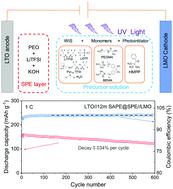当前位置:
X-MOL 学术
›
Energy Environ. Sci.
›
论文详情
Our official English website, www.x-mol.net, welcomes your
feedback! (Note: you will need to create a separate account there.)
“Water-in-salt” polymer electrolyte for Li-ion batteries
Energy & Environmental Science ( IF 32.4 ) Pub Date : 2020-07-30 , DOI: 10.1039/d0ee01510e Jiaxun Zhang 1, 2, 3, 4 , Chunyu Cui 1, 2, 3, 4 , Peng-Fei Wang 1, 2, 3, 4 , Qin Li 1, 2, 3, 4 , Long Chen 1, 2, 3, 4 , Fudong Han 1, 2, 3, 4 , Ting Jin 1, 2, 3, 4 , Sufu Liu 1, 2, 3, 4 , Hema Choudhary 1, 2, 3, 4 , Srinivasa R. Raghavan 1, 2, 3, 4 , Nico Eidson 1, 2, 3, 4, 5 , Arthur von Cresce 5, 6, 7, 8, 9 , Lin Ma 5, 6, 7, 8, 9 , Jasim Uddin 4, 10, 11 , Dan Addison 4, 10, 11 , Chongyin Yang 1, 2, 3, 4 , Chunsheng Wang 1, 2, 3, 4, 12
Energy & Environmental Science ( IF 32.4 ) Pub Date : 2020-07-30 , DOI: 10.1039/d0ee01510e Jiaxun Zhang 1, 2, 3, 4 , Chunyu Cui 1, 2, 3, 4 , Peng-Fei Wang 1, 2, 3, 4 , Qin Li 1, 2, 3, 4 , Long Chen 1, 2, 3, 4 , Fudong Han 1, 2, 3, 4 , Ting Jin 1, 2, 3, 4 , Sufu Liu 1, 2, 3, 4 , Hema Choudhary 1, 2, 3, 4 , Srinivasa R. Raghavan 1, 2, 3, 4 , Nico Eidson 1, 2, 3, 4, 5 , Arthur von Cresce 5, 6, 7, 8, 9 , Lin Ma 5, 6, 7, 8, 9 , Jasim Uddin 4, 10, 11 , Dan Addison 4, 10, 11 , Chongyin Yang 1, 2, 3, 4 , Chunsheng Wang 1, 2, 3, 4, 12
Affiliation

|
Recent success in extending the electrochemical stability window of aqueous electrolytes to 3.0 V by using 21 mol kg-1 “water-in-salt” (WiS) has raised a high expectation for developing safe aqueous Li-ion batteries. However, the most compatible Li4Ti5O12 anodes still cannot use WiS electrolyte due to the cathodic limit (1.9 V vs. Li/Li+). Herein, a UV-curable hydrophilic polymer is introduced to further extend the cathodic limit of WiS electrolytes and replace the separator. In addition, a localized strongly basic solid polymer electrolyte (SPE) layer is coated on the anode to promote the formation of an LiF-rich SEI. The synthetic impacts of UV-crosslinking and local alkaline SPE on the anodes extend the electrochemical stability window of the solid-state aqueous polymer electrolyte to ∼3.86 V even at a reduced salt concentration of 12 mol kg−1. It enables a separator-free LiMn2O4//Li4Ti5O12 aqueous full cell with a practical capacity ratio (P/N = 1.14) of the cathode and anode to deliver a steady energy density of 151 W h kg−1 at 0.5C with an initial Coulombic efficiency of 90.50% and cycled for over 600 cycles with an average Coulombic efficiency of 99.97%, which has never been reported before for an aqueous LiMn2O4//Li4Ti5O12 full cell. This flexible and long-duration aqueous Li-ion battery with hydrogel WiSE can be widely used as a power source in wearable devices and electrical transportations where both energy density and battery safety are of high priority. An ultra-thick LTO electrode with UV-curable polymer electrolyte as the binder is demonstrated as a solid state battery electrode. And a high-voltage (7.4 V) solid-state bipolar cell is assembled with a solid-state UV-curable polymer as the electrolyte.
中文翻译:

锂离子电池的“盐包水”聚合物电解质
通过使用21 mol kg -1的“盐包水”(WiS)将水性电解质的电化学稳定性窗口扩展至3.0 V的最新成功,对开发安全的水性锂离子电池抱有很高的期望。然而,由于阴极限制(1.9 V vs. Li / Li +,最兼容的Li 4 Ti 5 O 12阳极仍不能使用WiS电解质)。在本文中,引入可UV固化的亲水性聚合物以进一步扩展WiS电解质的阴极极限并替换隔膜。另外,在阳极上涂覆局部的强碱性固体聚合物电解质(SPE)层,以促进富LiF的SEI的形成。UV交联和局部碱性SPE对阳极的合成影响将固态水性聚合物电解质的电化学稳定性窗口扩展到了约3.86 V,即使盐浓度降低了12 mol kg -1。它可以实现无隔板的LiMn 2 O 4 // Li 4 Ti 5 O 12含水全电池,其阴极和阳极的实际容量比(P / N = 1.14)可在0.5C时提供151 W h kg -1的稳定能量密度,初始库仑效率为90.50%,并循环600多个循环LiMn 2 O 4 // Li 4 Ti 5 O 12的平均库仑效率为99.97%,这是前所未有的满格的。这种具有水凝胶WiSE的灵活,耐用的水性锂离子电池可广泛用作能量密度和电池安全性都至关重要的可穿戴设备和电力运输中的电源。以紫外线固化型高分子电解质为粘合剂的超厚LTO电极被证明是固态电池电极。然后,以固态可紫外线固化的聚合物为电解质组装高压(7.4 V)固态双极电池。
更新日期:2020-09-16
中文翻译:

锂离子电池的“盐包水”聚合物电解质
通过使用21 mol kg -1的“盐包水”(WiS)将水性电解质的电化学稳定性窗口扩展至3.0 V的最新成功,对开发安全的水性锂离子电池抱有很高的期望。然而,由于阴极限制(1.9 V vs. Li / Li +,最兼容的Li 4 Ti 5 O 12阳极仍不能使用WiS电解质)。在本文中,引入可UV固化的亲水性聚合物以进一步扩展WiS电解质的阴极极限并替换隔膜。另外,在阳极上涂覆局部的强碱性固体聚合物电解质(SPE)层,以促进富LiF的SEI的形成。UV交联和局部碱性SPE对阳极的合成影响将固态水性聚合物电解质的电化学稳定性窗口扩展到了约3.86 V,即使盐浓度降低了12 mol kg -1。它可以实现无隔板的LiMn 2 O 4 // Li 4 Ti 5 O 12含水全电池,其阴极和阳极的实际容量比(P / N = 1.14)可在0.5C时提供151 W h kg -1的稳定能量密度,初始库仑效率为90.50%,并循环600多个循环LiMn 2 O 4 // Li 4 Ti 5 O 12的平均库仑效率为99.97%,这是前所未有的满格的。这种具有水凝胶WiSE的灵活,耐用的水性锂离子电池可广泛用作能量密度和电池安全性都至关重要的可穿戴设备和电力运输中的电源。以紫外线固化型高分子电解质为粘合剂的超厚LTO电极被证明是固态电池电极。然后,以固态可紫外线固化的聚合物为电解质组装高压(7.4 V)固态双极电池。











































 京公网安备 11010802027423号
京公网安备 11010802027423号